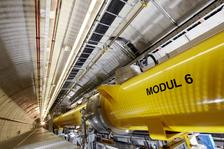FLASH tunnel at the accelerator modul 6
FLASH is a high-gain free-electron laser (FEL) which achieves laser amplification and saturation within a single pass of the electron bunch through a long undulator section. The lasing process is initiated by spontaneous undulator radiation. The FEL works in the so-called Self-Amplified Spontaneous Emission (SASE) mode without needing an external input signal.
The electron bunches are produced in a laser-driven photoinjector and accelerated by a superconducting linear accelerator. The RF-gun based photoinjector allows the generation of electron bunches with tiny emittances - mandatory for an efficient SASE process.The superconducting technology allows to accelerate thousands of bunches per second, which is not possible with other technologies. At intermediate energies of 150 and 450 MeV the electron bunches are longitudinally compressed, thereby increasing the peak current from initially 50-80 A to 1-2 kA - as required for the lasing process in the undulator.
The 27 m long undulator consists of permanent NdFeB magnets with a fixed gap of 12 mm, a period length of 27.3 mm and peak magnetic field of 0.47 T. The electrons interact with the undulator field in such a way, that so called micro bunches are developed. These micro bunches radiate coherently and produce intense X-ray pulses. Finally, a dipole magnet deflects the electron beam safely into a dump, while the FEL radiation propagates to the experimental hall.
The current FLASH photon beam parameters can be found here.






